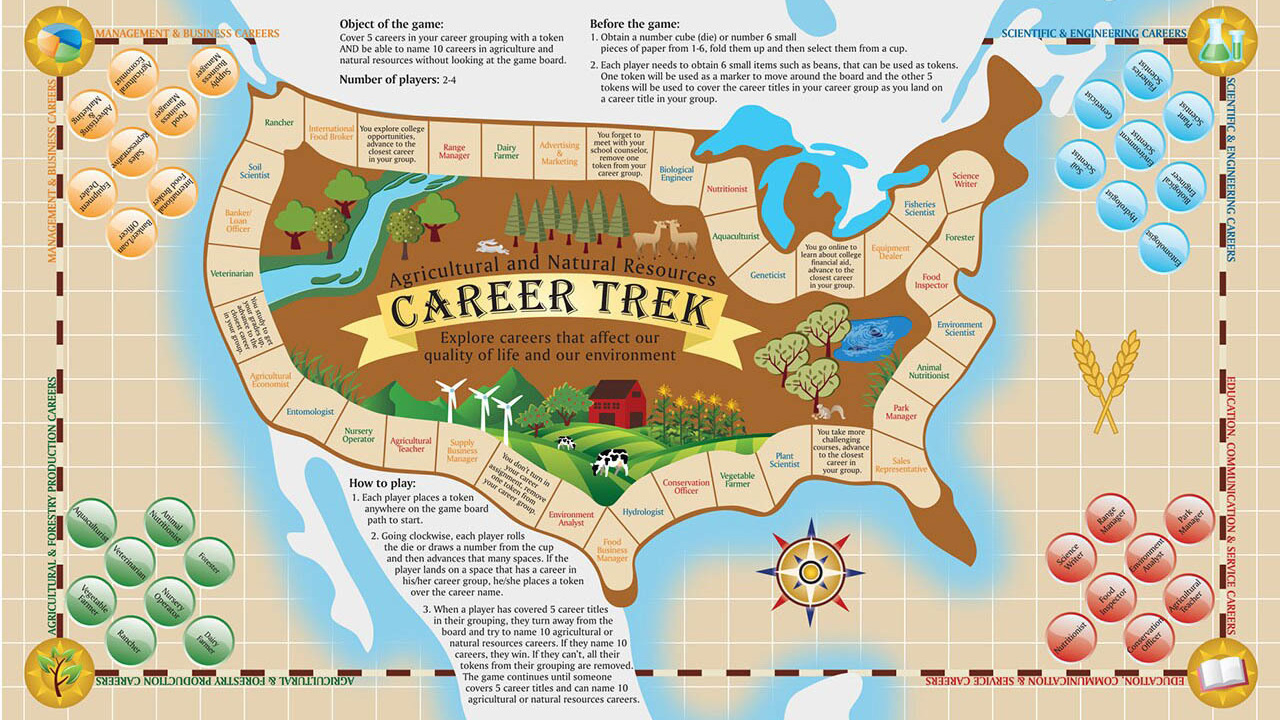Lesson Plan
Career Trek
Grade Level
Purpose
Students will explore careers in the fields of agriculture and natural resources through online research. They will check their understanding by playing Career Trek—a board game that requires students to identify careers in agriculture and natural resources. Grades 6-8
Estimated Time
Materials Needed
Activity 1
- Career Assessment activity sheet, 1 per student
- Hexagon Graph activity sheet, 1 per student
- Responses to the Career Assessment handout and Agricultural Career Options activity sheets A and B, printed copies or the ability to project these pages
- What’s Been Your Agricultural Experience Today? PowerPoint slides
- Agriculture Careers According to the Holland Code activity sheet (optional)
Activity 2
- Agricultural Careers Prezi presentation
- Computers with internet access for students to view videos on careers in agriculture
- Careers in Agriculture video playlist
- Access to the National FFA Ag Explorer website
Evaluation
- Career Trek game board, 1 for every 4 students
Vocabulary
career: an occupation undertaken for a significant period of a person's life and with opportunities for progress; generally a profession requiring special training
Did You Know?
- Only 10% of Americans are involved in a career in traditional farming or ranching.1
- Agriculture careers include those in business, building, agriscience, horticulture, forestry, food science, wildlife, and more.1
- Approximately 22 million people work in agriculture related fields. 1
Background Agricultural Connections
Considering a career in agriculture and natural resources? Can you name ten careers in these fields? Careers in agriculture and natural resources provide people with the things they use every day: food, clothing, and shelter. Farmers and ranchers work with a multitude of scientists, technicians, business people, and educators to produce safe, inexpensive food. Researchers and scientists help to develop new seeds, safer crop protection, and more efficient machines that are part of a large, complex system that provides us with the things we use every day. Opportunities have expanded in the field of agriculture to include unique positions in sustainable farm management systems, biotechnology, forestry, marketing, engineering, and more.
Employment opportunities for US college graduates with expertise in food, agriculture, natural resources, and the environment are expected to remain strong during the next five years, according to the United States Department of Agriculture report Employment Opportunities for College Graduates in Food, Agriculture, and Natural Resources. This study, which is conducted every five years, identifies the number of graduates earning degrees in agriculture, natural resources, veterinary medicine, or closely allied specializations and estimates the percentage of those graduates who are expected to enter occupations in their field of study. This information is combined with projections of future employment opportunities in the same fields.
The most recent study predicts an average of 57,900 annual job openings for new graduates from 2015 through 2020. An average of 35,400 graduates with expertise in food, agriculture, renewable natural resources, or the environment are expected to fill many of these job openings. In addition, many employers will look for qualified graduates from allied fields, including biological sciences, engineering, business administration, communication, education, and consumer sciences. Six major factors will define the market for graduates in the next five years: macroeconomic conditions and retirements; growing number of qualified graduates; changing consumer preferences for foods and biomaterials, public policy choices, technological advancements, and global market shifts in population, income, food, and energy. Some of the future careers in agriculture are yet to be defined; they are the emerging careers in agriculture.
Most people want to spend their work time doing something they enjoy, but many have a hard time deciding what type of job they would enjoy. The Holland Theory is a way to evaluate what types of activities you enjoy or interests you have and match these to jobs you might enjoy. By answering a few questions, students may find out which agricultural and natural resource careers might match their talents and capabilities.
People usually enjoy working in environments that allow them to associate with like-minded individuals. There are six different types of working environments: realistic, investigative, artistic, enterprising, social, and conventional. Many people are a combination of types and may consider working in careers that combine two or more types of environments. Today there are hundreds of fields of study and employment in agriculture. Take the time to explore some of the careers awaiting you.
Engage
- Ask your students if they have an idea of which career(s) they might be interested in choosing when they are older. Allow several students to offer their ideas.
- Point out to your students that there are many different areas where they can choose careers. Briefly explain a few areas such as education, business, medicine, etc.
- Explain that another career area they could choose is agriculture or natural resources. Ask students, "What kind of careers do you think are found in the agriculture industry?" Students will likely identify careers specific to farming and ranching. Explain to students that being a farmer or rancher who raises animals or crops is actually only the beginning. In this lesson students will be exposed to many more careers in agriculture.
Explore and Explain
Activity 1: Interest Assessment
- Provide each student with a Career Assessment and Hexagon Graph worksheet. Ask students to answer the questions on the Career Assessment activity sheet.
- Project the Responses to the Career Assessment page and go through it. Ask students to follow along, indicating which characteristics they’ve chosen by making tally marks on the Hexagon Graph sheet.
- When you have finished, instruct students to add up the number of tallies after each characteristic.
- Each student should have one or two characteristics that have more tally marks than the others. Ask them to color these areas on the Hexagon Graph sheet.
- Hand out or project Agricultural Career Options sheets A and B. Students should focus on the activity sheet with the characteristics for which they had the most tallies. Sheet A includes areas of study and career possibilities that may interest persons who are more realistic, artistic, or investigative. Sheet B covers those who are more enterprising, social, or conventional.
- Ask each student to choose one or more career(s) from the career possibilities list that interests him or her.
- Each student should research the career he or she chose and list job responsibilities, education requirements, salary, and how it relates to production agriculture. Most of this information can be found in the What’s Been Your Agricultural Experience Today? PowerPoint slides.
- Optional: Have students explore careers in each of the interest areas using the Agricultural Careers According to the Holland Code activity sheet.

Activity 2: Video Review
- Ask students to view, or view together, the Agricultural Careers Prezi presentation.
- Knowing what they know about their interests, the education they are willing to consider, and their pay expectations, ask students to view one or more of the two-minute agricultural and natural resources careers videos found on the Careers in Agriculture playlist.
- After the students view one of the career videos, have them visit the National FFA Ag Explorer to determine the salary range of each career.
- Ask students to share with the class what they viewed, something new they learned about the career, and the potential salary. It is possible there will be multiple students viewings of some movies; if so, ask these students to report as a group.
Evaluate
Concept Elaboration and Evaluation
- Use the Career Trek Game to assess basic student knowledge about agricultural and natural resource careers. The game includes a list of 32 careers, but this lesson has exposed students to over 100 careers. Tell students it is permissible to mention agricultural and natural resource careers that have been discussed in class but are not on the game board (the group needs to agree that the occupation stated is an agricultural or natural resource career, like agreeing on a word in Scrabble). An occupation title can always be checked by using Google or the National FFA Ag Explorer. When all students can name at least 10 agricultural and natural resource careers, they have met the core objectives.

- To further assess students, ask students to place the careers noted in the PowerPoint, in the Prezi, or on the Career Trek game into the appropriate Career Pathway category noted on the Utah Career Technical Education website.
- After conducting these activities, review and summarize the following key concepts:
- Careers in production agriculture include farmers and ranchers. Typically these careers are directly involved with the growing of crops or the raising of animals.
- In addition to production agriculture there are many careers in fields related to agriculture such as business, science, nutrition, and more.
Sources
- http://www.agday.org/education/careers.php
Recommended Companion Resources
- Ag & Food Careers
- Careers Ag Mag
- Careers in Agriculture
- Connecting to Agriculture
- Corteva Grows Science: Outreach Career Paths
- Employment Opportunities for College Graduates in Food, Renewable Energy, and the Environment
- Field to Film Career Snapshots
- Living Science Careers Equipment Bags
- Pathful Connect
- Planet Zorcon
Author
Organization
| We welcome your feedback! If you have a question about this lesson or would like to report a broken link, please send us an email. If you have used this lesson and are willing to share your experience, we will provide you with a coupon code for 10% off your next purchase at AgClassroomStore. |
